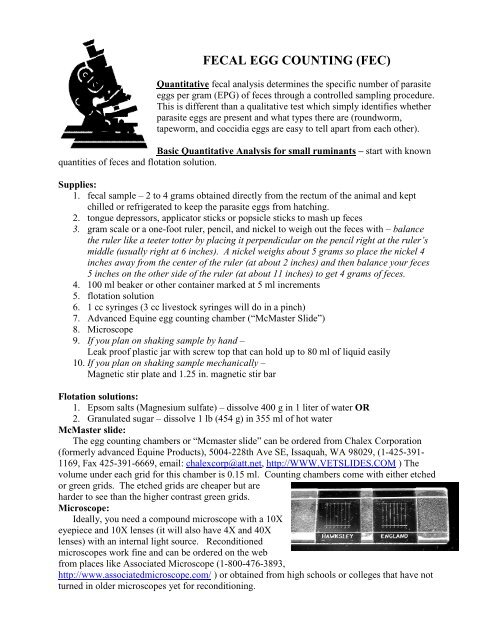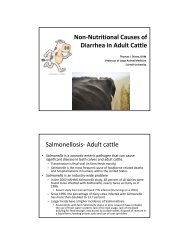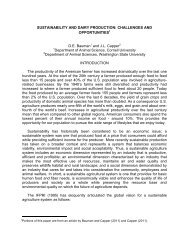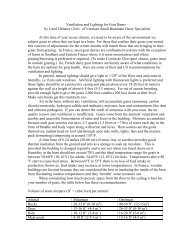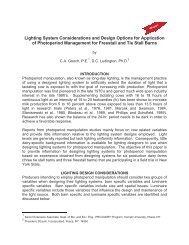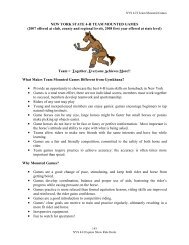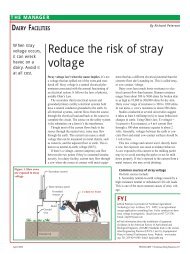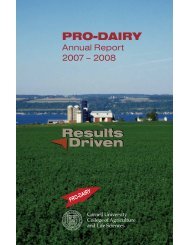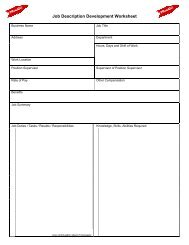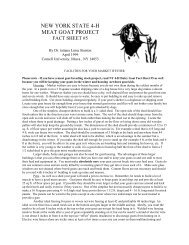A Basic Quantitative Fecal Examination Method for Small Ruminants
A Basic Quantitative Fecal Examination Method for Small Ruminants
A Basic Quantitative Fecal Examination Method for Small Ruminants
Create successful ePaper yourself
Turn your PDF publications into a flip-book with our unique Google optimized e-Paper software.
FECAL EGG COUNTING (FEC)<strong>Quantitative</strong> fecal analysis determines the specific number of parasiteeggs per gram (EPG) of feces through a controlled sampling procedure.This is different than a qualitative test which simply identifies whetherparasite eggs are present and what types there are (roundworm,tapeworm, and coccidia eggs are easy to tell apart from each other).<strong>Basic</strong> <strong>Quantitative</strong> Analysis <strong>for</strong> small ruminants – start with knownquantities of feces and flotation solution.Supplies:1. fecal sample – 2 to 4 grams obtained directly from the rectum of the animal and keptchilled or refrigerated to keep the parasite eggs from hatching.2. tongue depressors, applicator sticks or popsicle sticks to mash up feces3. gram scale or a one-foot ruler, pencil, and nickel to weigh out the feces with – balancethe ruler like a teeter totter by placing it perpendicular on the pencil right at the ruler’smiddle (usually right at 6 inches). A nickel weighs about 5 grams so place the nickel 4inches away from the center of the ruler (at about 2 inches) and then balance your feces5 inches on the other side of the ruler (at about 11 inches) to get 4 grams of feces.4. 100 ml beaker or other container marked at 5 ml increments5. flotation solution6. 1 cc syringes (3 cc livestock syringes will do in a pinch)7. Advanced Equine egg counting chamber (“McMaster Slide”)8. Microscope9. If you plan on shaking sample by hand –Leak proof plastic jar with screw top that can hold up to 80 ml of liquid easily10. If you plan on shaking sample mechanically –Magnetic stir plate and 1.25 in. magnetic stir barFlotation solutions:1. Epsom salts (Magnesium sulfate) – dissolve 400 g in 1 liter of water OR2. Granulated sugar – dissolve 1 lb (454 g) in 355 ml of hot waterMcMaster slide:The egg counting chambers or “Mcmaster slide” can be ordered from Chalex Corporation(<strong>for</strong>merly advanced Equine Products), 5004-228th Ave SE, Issaquah, WA 98029, (1-425-391-1169, Fax 425-391-6669, email: chalexcorp@att.net, http://WWW.VETSLIDES.COM ) Thevolume under each grid <strong>for</strong> this chamber is 0.15 ml. Counting chambers come with either etchedor green grids. The etched grids are cheaper but areharder to see than the higher contrast green grids.Microscope:Ideally, you need a compound microscope with a 10Xeyepiece and 10X lenses (it will also have 4X and 40Xlenses) with an internal light source. Reconditionedmicroscopes work fine and can be ordered on the webfrom places like Associated Microscope (1-800-476-3893,http://www.associatedmicroscope.com/ ) or obtained from high schools or colleges that have notturned in older microscopes yet <strong>for</strong> reconditioning.
Magnetic stirrer:Refurbished magnetic stirrers are also available on the web. One source is MedicalResources USA (1- 800 330-3591, http://www.medicalresources.com/ )Procedure:1. Using a tongue depressor, weigh out 2 to 4 gm of feces into beaker.2. Break up the fecal pellets and add the correct amount of flotation solution to the feces to makea slurry. You’ll need a total of 56 ml flotation solution <strong>for</strong> 4 g of feces, 42 mls <strong>for</strong> 3 g or 28 ml<strong>for</strong> 2 gm. It is easiest to add just a little of your floatation solution to first break up the fecalpellets and then add the remainder of the solution. For example, <strong>for</strong> 4 g of feces, you can addabout 20 ml flotation solution to help break up the feces using the tongue depressor to breaklumps. Then bring the slurry up to the 60 ml mark on your beaker using the remainder of yourflotation solution. . If you do not have a scale, keep in mind that a gram of feces isapproximately 1 ml in volume. Thus, you can put 28 mls of solution into a beaker and thenadd enough feces to bring the liquid level to 30 mls, etc.3. Add a stir bar, and stir on a magnetic stirrer at medium speed <strong>for</strong> 5 min. OR put in aleakproof jar and shake vigorously <strong>for</strong> 5 minutes.4. At the end of 5 minutes, while mixture is still stirring, draw about 1 ml fecal suspension fromthe upper layers of the slurry into your syringe.5. Load one side of counting chamber carefully to avoid producing bubbles – each chamberholds about .15 ml of slurry and repeat sampling and loading procedure <strong>for</strong> second side ofchamber.6. Let preparation stand a minimum of 5 min (examine it at least by 20 min.)7. Place chamber on microscope and examine with 10 X objective (Adjust the focus until youcan see grid lines clearly and then refine your focus to the air bubble layer).8. Count eggs in both sides of chamber- each chamber or grid has six sections. Do not count eggsoutside the grid. Calculate the number of eggs per gram of feces: (side 1 + side 2) X 50Notes: <strong>Fecal</strong> egg counts are a useful measure of potential pasture contamination. They are notnecessarily correlated to worm numbers or to the severity of parasitic disease. Paired samplesfrom the same animals be<strong>for</strong>e and after (7-10 days) deworming will help determine theeffectiveness of an anthelmintic treatment. Failure to achieve at least 90 percent reduction offecal egg counts is suggestive of worm resistance. Severe resistance is present when egg countreduction is less than 60 percent. When doing fecal egg counts, keep in mind that cat, dog, sheep,or goat feces, which contain a lot of clay-like fine particulate matter, may need more dilutionthan horse or cow feces that contain coarser particulates.Strongyle eggs Tapeworm egg Coccidia eggs
Langston University methodof preparing fecals <strong>for</strong> egg countingEquipment neededFresh feces stored up to 7 days in refrigerator (do not freeze). You can mash pellets together andsqueeze all the air out of the ziplock bag and they will store better.30 cc syringe3 cc syringe with end cut offPopsicle stick or tongue depressor or spoonEye dropper or pipette or another small syringe (3 cc or less)Flotation solution such as 1 ¼ cups of sugar mixed into 1 cup of water<strong>Small</strong> glass bowl (i.e. custard dish, salsa bowl)Plastic tea strainerMcMaster slide, microscope, etc.Procedure1. Mash fecal pellets into the 3 cc syringe and <strong>for</strong>m a solid column of feces. Push plunger to 2cc mark and cut off. Push the 2 cc of feces into a tea strainer resting in the glass bowl.2. Fill 30 cc syringe with 28 cc of flotation solution and add to the tea strainer in the glass bowl.3. Use depressor or spoon to crush and break up feces into a slurry in the tea strainer. Finerparticles and liquid will be pushed out into glass bowl.4. Lift tea strainer out of bowl and discard the residue in it.5. Stir solution in glass bowl 8 times and use an eye dropper, small syringe or pipette to fill onechamber of your “McMaster Slide”. Stir solution 8 times again and fill the other chamber. Letslide sit <strong>for</strong> 5 minutes be<strong>for</strong>e looking at it under your microscope.


